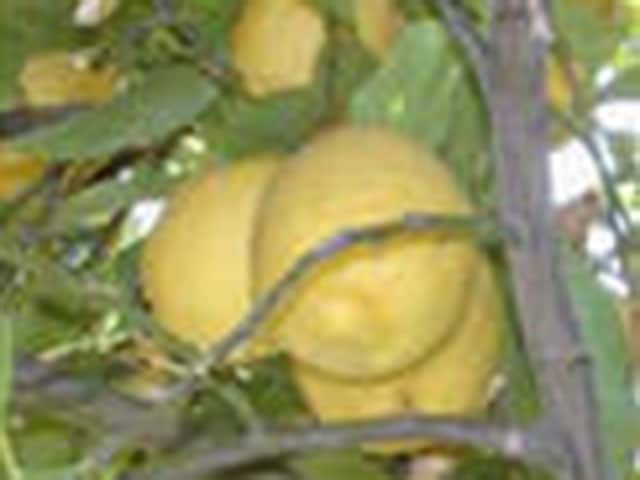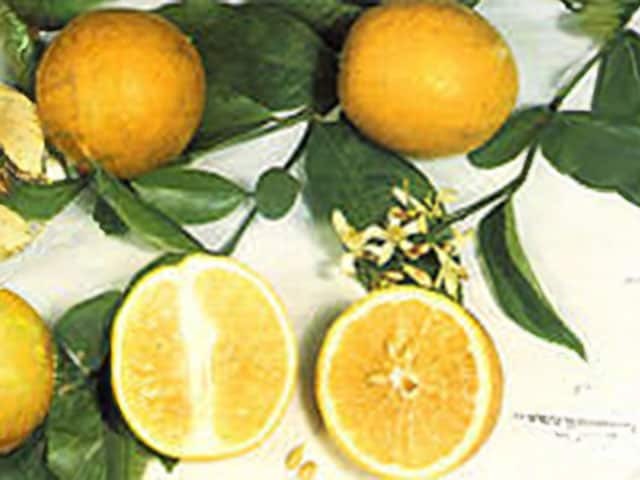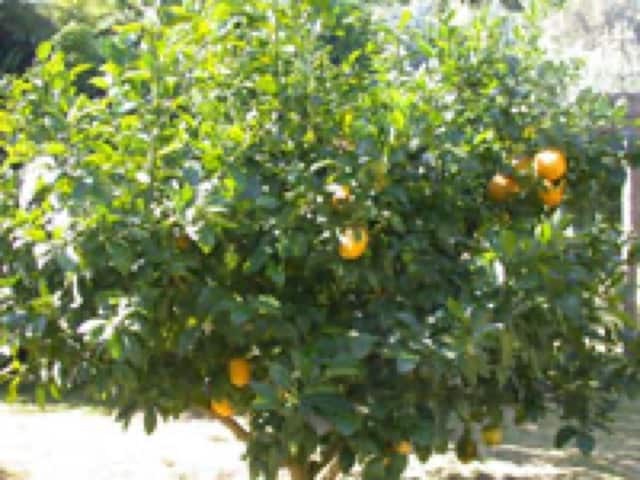Main menu
Common skin conditions

NEWS
Join DermNet PRO
Read more
Quick links
Lemon — extra information
Common name: |
Lemon |
|
Botanical name: |
Citrus limon |
|
Family: |
Rutaceae |
|
Origin: |
The true home of the lemon is unknown, although it probably comes from north-western India/Himalaya. It is supposed to have been introduced into southern Italy in 200 A.D. and to have been cultivated in Iraq and Egypt by 700 A.D. It reached Sicily before 1000 and China between 760 and 1297 A.D. Arabs distributed it widely in the Mediterranean region between 1000 and 1150 A.D. It was prized for its medicinal virtues in the palace of the Sultan of Egypt and Syria in the period 1174-1193 A.D. Christopher Columbus carried lemon seeds to the New World in 1493. |
|
Description: |
The true lemon tree reaches 3-6 m in height and usually has sharp thorns on the twigs. The alternate leaves, reddish when young, become dark-green above, light-green below; are oblong, elliptic or long-ovate, 6.25-11.25 cm long, finely toothed, with slender wings on the petioles. The mildly fragrant flowers may be solitary or there may be 2 or more clustered in the leaf axils. Buds are reddish; the opened flowers have 4 or 5 petals 2 cm long, white on the upper surface (inside), purplish beneath (outside), and 20-40 more or less united stamens with yellow anthers. The fruit is oval with a nipple-like protuberance at the apex; 7 -12 cm long; the peel is usually light-yellow though some lemons are variegated with longitudinal stripes of green and yellow or white; it is aromatic, dotted with oil glands; 6-10 mm thick; pulp is pale-yellow, in 8 to 10 segments, juicy, acid. Some fruits are seedless, most have a few seeds, elliptic or ovate, pointed, smooth, 9.5 mm long, white inside. |
|



Uses: |
Used as foods and garnishes. Lemon juice is added extensively to carbonated beverages, pies and tarts, as a flavouring for bakery, confectionery, preserves and pharmaceutical products. Lemon juice is a stain remover and has been used for bleaching freckles and is incorporated into some facial cleansing creams. Lemon peel oil is used in furniture polishes, detergents, soaps and shampoos. It is important in perfume blending and especially in colognes. Lemon peel, dehydrated, is marketed as cattle feed. The wood is fine-grained, compact, and easy to work. Lemon juice has traditionally been used as a diuretic, antiscorbutic, astringent, and febrifuge. In Italy, the sweetened juice is given to relieve gingivitis, stomatitis, and inflammation of the tongue. Lemon juice in hot water has been widely advocated as a daily laxative and preventive of the common cold, but daily doses have been found to erode the enamel of the teeth. Prolonged use will reduce the teeth to the level of the gums. Oil expressed from lemon seeds is employed medicinally. |
|
Allergens: |
Psoralens (bergapten), geraniol, citral, D-limonene |
|
Allergy: |
Citrus fruit, notably lemon and C. bergamia (the source of bergamot oil) are important causes of Phototoxic reactions. The peel of lemon is also irritant and may cause contact urticaria. Allergic contact dermatitis is unusual although it hand dermatitis has been reported in food handlers who had become sensitised to lemons. Citrus fruit peel is often waxed and dyed. Sensitisation may be due to carnauba wax or dyes such as carotene and Citrus Red 3 dye. |
|
Cross reactions: |
||
Other information: |
It was the juice of the Mediterranean sweet lemon, not the lime, that was carried aboard British sailing ships of the 18th Century to prevent scurvy, though the sailors became known as "limeys". |
|
Patch test: |
Lemon peel as is (may irritate), 5-10% dispersion in petrolatum, ether extract, 5% citrus in petrolatum, balsam of Peru, 10% geraniol |
|
References
- Vilaplana J, Romaguera C. Contact dermatitis from the essential oil of tangerine in fragrance. Contact Dermatitis. 2002 Feb;46(2):108.
- Wagner AM, Wu JJ, Hansen RC, Nigg HN, Beiere RC. Bullous phytophotodermatitis associated with high natural concentrations of furanocoumarins in limes. J Contact Dermat. 2002 Mar;13(1):10-4.
- Wohrl S, Hemmer W, Focke M, Gotz M, Jarisch R. The significance of fragrance mix, balsam of Peru, colophony and propolis as screening tools in the detection of fragrance allergy. Br J Dermatol. 2001 Aug;145(2):268-73.
- Solis RR, Dotson DA, Trizna Z. Phytophotodermatitis: a sometimes difficult diagnosis. Arch Fam Med. 2000 Nov-Dec;9(10):1195-6.
- Bergeson PS, Weiss JC. Picture of the month. Phytophotodermatitis. Arch Fam Med. 2000 Jul;9(7):585-6.
- Ahmed I, Charles-Holmes R. Phytophotodermatitis mimicking superficial lymphangitis. Br J Dermatol. 2000 May;142(5):1069.
- Bosch JJ. Phytophotodermatitis. J Pediatr Health Care. 1997 Mar-Apr;11(2):84, 97-8.
- Audicana M, Bernaola G. Occupational contact dermatitis from citrus fruits: lemon essential oils. Contact Dermatitis. 1994 Sep;31(3):183-5.
- Goskowicz MO, Friedlander SF, Eichenfield LF. Endemic "lime" disease: phytophotodermatitis in San Diego County. Pediatrics. 1994 May;93(5):828-30.
- Nigg HN, Nordby HE, Beier RC, Dillman A, Macias C, Hansen RC. Phototoxic coumarins in limes. Food Chem Toxicol. 1993 May;31(5):331-5
- Poljacki M, Paravina M, Jovanovic M, Subotic M, Duran V. [Contact allergic dermatitis caused by plants]. Med Pregl. 1993;46(9-10):371-5. Serbo-Croatian (Roman).
- Hausen BM, Kulenkamp D. [Geraniol contact allergy]. Z Hautkr. 1990 May;65(5):492-4. German.
- Serrano G, Pujol C, Cuadra J, Gallo S, Aliaga A. Riehl's melanosis: pigmented contact dermatitis caused by fragrances. J Am Acad Dermatol. 1989 Nov;21(5 Pt 2):1057-60.
- Kubo M, Yano M, Matsuda H. [Pharmacological study on citrus fruits. I. Anti-allergic effect of fruit of Citrus unshiu Markovich (1)]. Yakugaku Zasshi. 1989 Nov;109(11):835-42. Japanese.
- Cardullo AC, Ruszkowski AM, DeLeo VA. Allergic contact dermatitis resulting from sensitivity to citrus peel, geraniol, and citral. J Am Acad Dermatol. 1989 Aug;21(2 Pt 2):395-7.
- Picardo M, Rovina R, Cristaudo A, Cannistraci C, Santucci B. Contact urticaria from Tilia (lime). Contact Dermatitis. 1988 Jul;19(1):72-3.
- Olumide Y. Contact dermatitis in Nigeria (i). Hand dermatitis in women. Contact Dermatitis. 1987 Aug;17(2):85-8.
- Saunders LD, Ames RG, Knaak JB, Jackson RJ. Outbreak of Omite-CR-induced dermatitis among orange pickers in Tulare County, California. J Occup Med. 1987 May;29(5):409-13.
- Niinimaki A. Scratch-chamber tests in food handler dermatitis. Contact Dermatitis. 1987 Jan;16(1):11-20.
- [No authors listed]. Outbreak of severe dermatitis among orange pickers--California. MMWR Morb Mortal Wkly Rep. 1986 Jul 25;35(29):465-7.
- Pathak MA. Phytophotodermatitis. Dermatol. 1986 Apr-Jun;4(2):102-21.
- Zacher KD, Ippen H. [Contact dermatitis caused by bergamot oil]. Derm Beruf Umwelt. 1984;32(3):95-7. German.
- Rothenborg HW, Menne T, Sjolin KE. Temperature dependent primary irritant dermatitis from lemon perfume. Contact Dermatitis. 1977 Feb;3(1):37-48.
- Speer F. Multiple food allergy. Ann Allergy. 1975 Feb;34(2):71-6.
- Lovell CR.1993, Plants and the Skin, Blackwell, Oxford.
- Mitchell JC, Rook A, 1979, Botanical Dermatology, Plants and Plant products injurious to the skin, Greengrass, Vancouver.
- Botanical Dermatology Database
